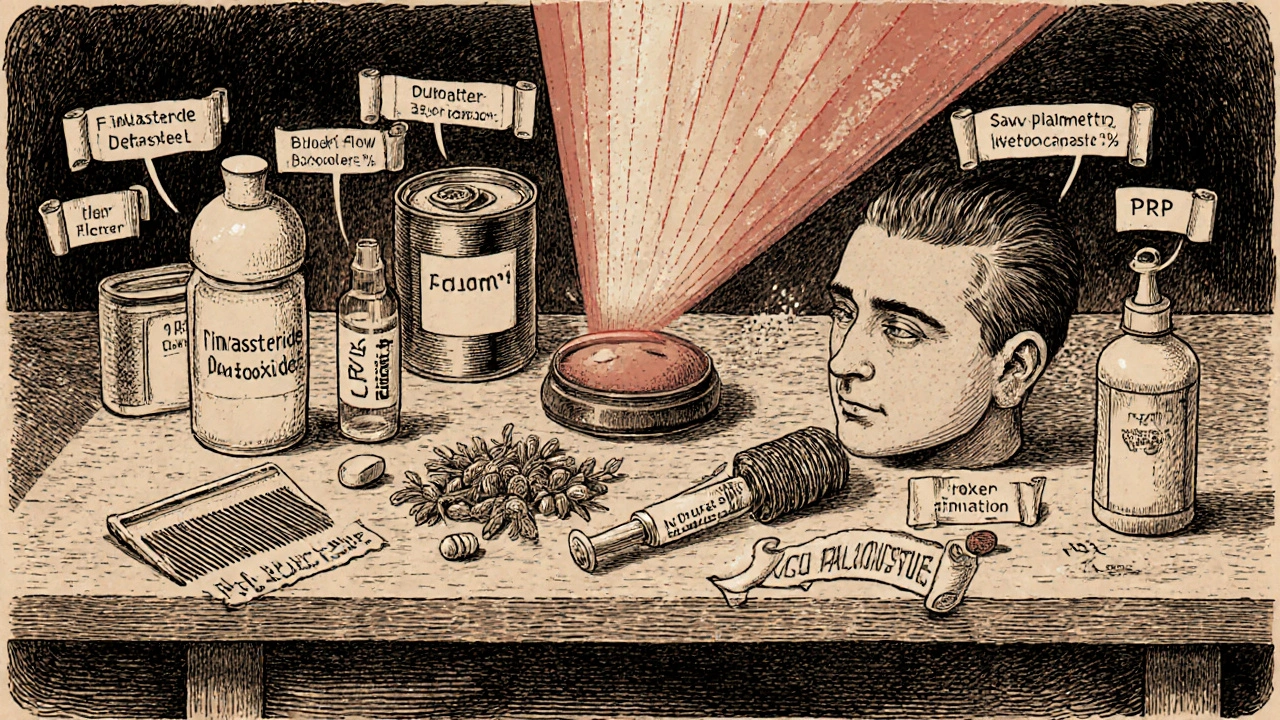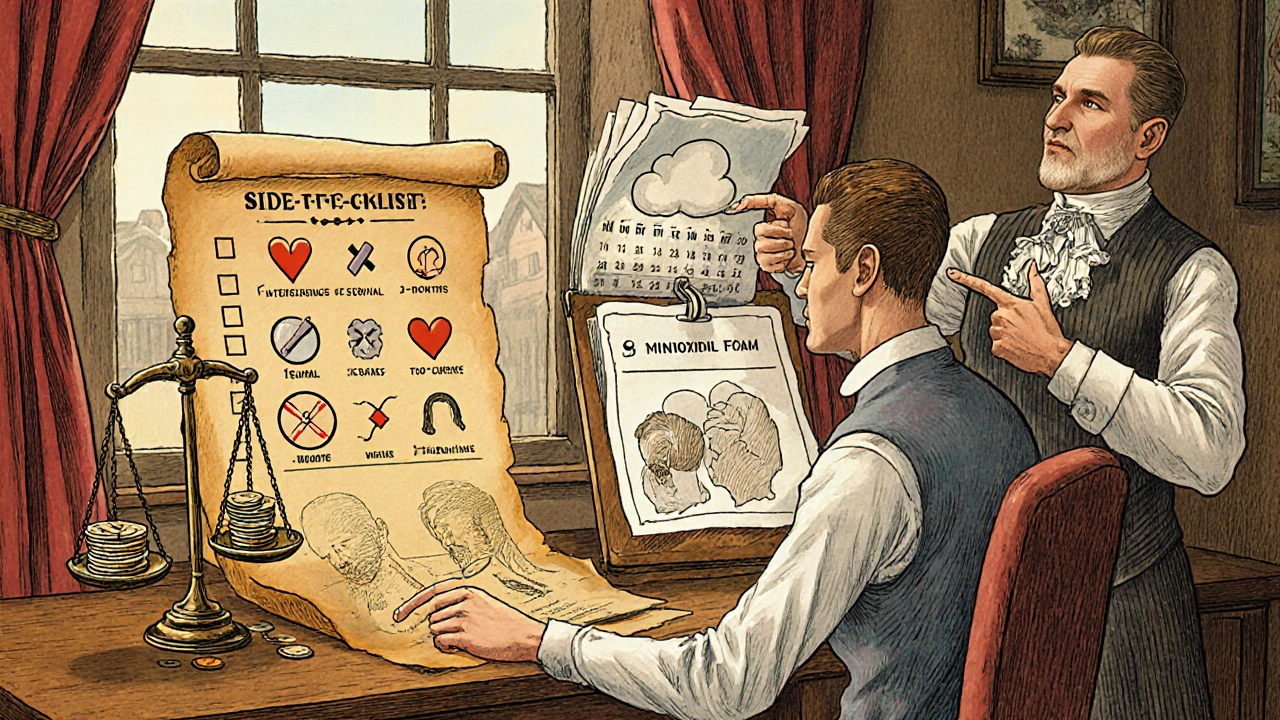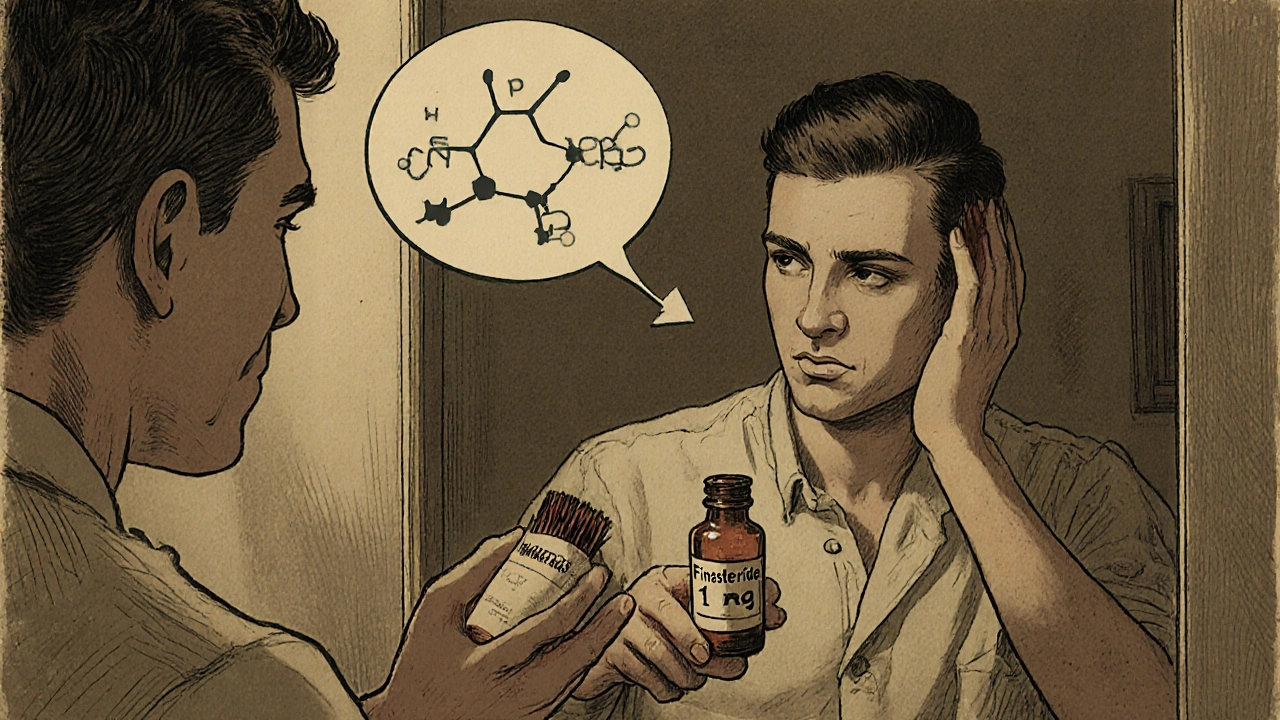Hair Loss Treatment Comparison Tool
Compare treatments based on your personal priorities. Adjust sliders to reflect your preferences for cost, efficacy, and side effect risk.
Your Priorities
Treatment Comparison
Adjust your priorities and click "Calculate Results" to see your personalized recommendations
If you’ve stared at the mirror and wondered whether the pills you’re taking are the best option for thinning hair, you’re not alone. Finasteride comparison is a hot topic among men battling androgenetic alopecia, and there’s a growing menu of alternatives that promise similar or even better results. This guide walks you through how Finasteride (Propecia) stacks up against the most common substitutes, so you can decide what fits your scalp, budget, and lifestyle.
What Is Finasteride (Propecia)?
When it comes to treating male pattern baldness, Finasteride (branded as Propecia) is a prescription oral medication that inhibits the conversion of testosterone to dihydrotestosterone (DHT). DHT is the hormone primarily responsible for shrinking hair follicles in androgenetic alopecia. By lowering DHT levels, Finasteride can slow hair loss and, in many cases, stimulate modest regrowth after three to six months of daily use.
How Finasteride Works
Finasteride belongs to a class called 5α‑reductase inhibitors. It targets the enzyme type II, which is most active in the scalp and prostate. The drug reduces circulating DHT by about 70 % in men, leading to a measurable decrease in follicular miniaturization. Clinical trials show that roughly 85 % of users experience a halt in hair loss, and about 65 % report visible regrowth on the crown area.
Key Benefits and Drawbacks of Finasteride
- Benefits: Oral, once‑daily dosing; clinically proven efficacy; relatively low cost with generic versions.
- Drawbacks: Potential sexual side effects (decreased libido, erectile dysfunction); rare but documented mood changes; requires prescription and regular monitoring.

Popular Alternatives to Finasteride
Below are the most frequently considered options. Each one tackles hair loss through a different mechanism, which can be useful if you can’t tolerate Finasteride or prefer a non‑oral approach.
Minoxidil (Topical)
Minoxidil is an over‑the‑counter topical solution or foam applied twice daily. It works by widening blood vessels in the scalp, enhancing nutrient delivery to hair follicles. Clinical data suggest a 30‑40 % regrowth rate in the vertex area after four months.
Dutasteride (Oral)
Dutasteride inhibits both type I and type II 5α‑reductase enzymes, lowering DHT up to 90 %. Though not FDA‑approved for hair loss, dermatologists often prescribe it off‑label. Studies report higher efficacy than Finasteride but with a similar side‑effect profile.
Low‑Level Laser Therapy (LLLT)
Low‑Level Laser Therapy, delivered via combs, helmets, or caps, uses red‑light wavelengths (630‑670 nm) to stimulate cellular activity in follicles. Trials show a 21‑25 % increase in hair density after 24 weeks.
Platelet‑Rich Plasma (PRP) Injections
Platelet‑Rich Plasma therapy involves drawing a small amount of the patient’s blood, concentrating platelets, and injecting the plasma into the scalp. Growth factors in PRP can prolong the anagen (growth) phase, with many studies noting a 30‑45 % improvement in thickness after three sessions.
Saw Palmetto (Herbal Supplement)
Saw Palmetto extract is a plant‑based DHT blocker. While evidence is mixed, a 2022 meta‑analysis found a modest 12 % reduction in hair shedding compared with placebo, making it a low‑risk, inexpensive option.
Ketoconazole Shampoo (Antifungal)
Ketoconazole 2 % shampoo, marketed for dandruff, also has anti‑androgen properties. Used two to three times weekly, it can add roughly 10 % extra hair density when combined with other treatments.
Hair Transplant Surgery
Hair transplant (FUE or FUT) physically moves donor follicles to balding zones. It provides a permanent, natural‑looking solution but involves higher cost, surgical risk, and a recovery period.
Side‑Effect Snapshot
Understanding the safety profile of each option helps you weigh the trade‑offs.
| Treatment | Common Side Effects |
|---|---|
| Finasteride | Sexual dysfunction, decreased libido, rare mood swings |
| Minoxidil | Scalp irritation, unwanted facial hair, rare hypotension |
| Dutasteride | Similar to Finasteride, potentially higher incidence of sexual side effects |
| LLLT | Minimal; occasional scalp warmth |
| PRP | Temporary redness, swelling, rarely infection |
| Saw Palmetto | Generally well‑tolerated; occasional stomach upset |
| Ketoconazole Shampoo | Dryness, mild itching |
| Hair transplant | Pain, swelling, scarring, infection risk |
Cost Overview (U.S. Prices, 2025)
Costs vary by region, brand, and insurance coverage. Below figures reflect typical out‑of‑pocket expenses.
| Treatment | Administration | FDA Status | Typical Efficacy | Side‑Effect Risk | Annual Cost |
|---|---|---|---|---|---|
| Finasteride (Propecia) | Oral 1 mg daily | Prescription | 30‑45 % regrowth | Low‑Moderate | $120‑$250 |
| Minoxidil 5 % | Topical twice daily | OTC | 30‑40 % regrowth | Low | $45‑$80 |
| Dutasteride 0.5 mg | Oral daily | Off‑label | 40‑55 % regrowth | Low‑Moderate | $150‑$300 |
| LLLT device | Home use 15 min 3×/week | Medical‑device | 21‑25 % density increase | Very Low | $400‑$1,200 (one‑time) |
| PRP therapy | In‑office injections (3×/yr) | Off‑label | 30‑45 % thickness boost | Low‑Moderate | $1,500‑$3,000 |
| Saw Palmetto | Oral supplement daily | Supplement | ~12 % shedding reduction | Very Low | $30‑$60 |
| Ketoconazole 2 % shampoo | Wash 2‑3×/wk | OTC | ~10 % extra density | Very Low | $20‑$45 |
| Hair transplant (FUE) | Surgical | Medical procedure | Permanent, 80‑90 % natural look | High (surgical) | $4,000‑$15,000 |

Choosing the Right Option for You
There’s no one‑size‑fits‑all answer. Consider these three decision points:
- Medical suitability: If you have a history of prostate issues, discuss finasteride or dutasteride with your doctor. Those with cardiovascular concerns may prefer topical agents.
- Commitment level: Oral pills need daily adherence; laser devices demand regular sessions; surgery is a one‑time investment.
- Budget: Generic finasteride is the cheapest prescription route, while PRP and transplants can run into thousands.
Many patients adopt a combo approach-Finasteride plus minoxidil, for instance-to target DHT suppression and follicle stimulation simultaneously.
Quick Checklist Before Starting Treatment
- Confirm diagnosis of androgenetic alopecia with a dermatologist.
- Discuss potential side effects and drug interactions (especially with other hormones).
- Set realistic expectations: most treatments need 3-6 months before visible changes.
- Plan for ongoing monitoring-blood tests for liver function if using dutasteride, or hormonal panels for long‑term finasteride use.
- Consider a backup plan (e.g., minoxidil) if you discontinue oral medication.
Frequently Asked Questions
Can I use finasteride and minoxidil together?
Yes. Combining the two is common practice because they work through different pathways-finasteride blocks DHT, while minoxidil boosts blood flow. Most studies show additive benefits without increasing side‑effects.
Is dutasteride more effective than finasteride?
Dutasteride suppresses both type I and type II 5α‑reductase enzymes, cutting DHT by about 90 % versus 70 % for finasteride. Clinical trials suggest higher regrowth rates, but the side‑effect profile is similar, and it’s not FDA‑approved for hair loss.
What are the long‑term risks of taking finasteride?
Most users tolerate finasteride well for years. Rare but reported concerns include persistent sexual dysfunction after discontinuation (post‑finasteride syndrome) and mood changes. Regular follow‑ups with your physician can help monitor any emerging issues.
Are natural supplements like saw palmetto a viable alternative?
Saw palmetto offers a mild DHT‑blocking effect with minimal side‑effects, but the evidence is less robust than prescription drugs. It may be worth trying if you prefer a supplement‑first approach, but don’t expect dramatic regrowth.
How does low‑level laser therapy compare to medication?
LLLT is non‑invasive and has virtually no side‑effects, but the hair‑density gains are modest (around 20 %). It works best as an adjunct to medication rather than a sole treatment.
Whether you stick with finasteride or venture into newer options, the key is to stay informed, monitor results, and adjust the plan with professional guidance. Your scalp’s health is a marathon, not a sprint-choose the strategy that you can keep up with for the long haul.


Charlene Gabriel
October 26, 2025 AT 18:29First off, congratulations on taking the initiative to dive deep into the world of hair‑loss treatments; that curiosity alone is a powerful step toward regaining confidence.
Understanding the biology behind DHT and how finasteride interferes with that conversion can feel daunting, but breaking it down into bite‑size pieces makes it manageable.
Finasteride’s strength lies in its proven track record; countless clinical studies show a significant slowdown in follicular miniaturization for the majority of men who stick with the regimen.
However, no single solution fits everyone, and individual response can vary based on genetics, age, and overall health.
That’s why it’s essential to look at the whole picture, including lifestyle factors like diet, stress management, and proper scalp hygiene.
When you pair finasteride with a topical like minoxidil, you’re essentially attacking hair loss from two angles – hormonal suppression and increased blood flow – which many dermatologists recommend for synergistic benefits.
If side‑effects are a concern, remember that dosage adjustments or intermittent scheduling have helped some patients mitigate issues while preserving efficacy.
For those who prefer non‑oral routes, low‑level laser therapy offers a low‑risk adjunct that can boost follicle activity without systemic exposure.
Platelet‑rich plasma, though more invasive, provides growth factors directly to the scalp, and studies suggest it can be especially effective when combined with medication.
Natural supplements such as saw palmetto may not match prescription potency, but they can serve as a gentle, low‑cost complement, especially for people wary of pharmaceuticals.
Cost considerations also play a role; generic finasteride remains the most budget‑friendly prescription, while procedures like hair transplants demand a larger upfront investment but deliver permanent results.
Regular follow‑ups with a dermatologist are crucial, not just for monitoring side‑effects but also for adjusting the treatment plan as your hair responds over time.
Patience is key – visible improvements typically emerge after three to six months, so staying consistent and tracking progress with photos can keep you motivated.
Remember, the journey is personal, and the best regimen is the one you can sustain without compromising your overall well‑being.
Stay hopeful, stay informed, and keep the dialogue open with your healthcare provider; you’re not alone in this marathon, and many have walked the path before you, emerging with thicker, healthier hair.
renee granados
October 31, 2025 AT 02:29Don't trust the pharma giants pushing finasteride – they want to lock you into a lifelong pill habit while they profit from your insecurities. The side‑effects are hidden on purpose. You might notice a drop in libido within weeks. It's all part of the control agenda.
Stephen Lenzovich
November 4, 2025 AT 10:29When you consider the American market's standards, finasteride remains a benchmark of efficacy, yet the broader spectrum of options reflects a global pursuit of excellence. While dutasteride may promise a higher DHT suppression, its off‑label status raises regulatory eyebrows, a fact many overlook in their haste for quick fixes. The nuanced interplay between dosage, patient compliance, and cultural attitudes toward medical interventions can hardly be reduced to a simple cost comparison. Moreover, technologies like low‑level laser therapy, though modest in their gains, showcase American ingenuity in non‑invasive solutions. It's essential to recognize that the patent‑driven landscape shapes both accessibility and innovation, and discerning patients must weigh these forces against personal health goals.
abidemi adekitan
November 8, 2025 AT 18:29Hey folks, let’s think of hair‑loss treatments like a vibrant palette – each colour adds depth to the final masterpiece. Finasteride offers a solid base, but why not splash in a dab of minoxidil for extra texture? If you’re adventurous, low‑level laser therapy can give that subtle shine, while PRP provides a burst of growth‑factor brilliance. Saw palmetto might be the gentle pastel that doesn’t overwhelm the canvas. Ultimately, blending these options, guided by a dermatologist, paints a fuller, richer picture of recovery.
laura balfour
November 13, 2025 AT 02:29Wow, this guide is like a blockbuster movie – full of twists, drama, and a hero’s journey for your scalp! The finasteride plotline is classic, but the side‑kick characters like laser caps and PRP bring that extra spark. I noticed a tiny typo in the table, but it didn’t distract from the epic feel. Remember, every hero needs backup, so a combo of finasteride and minoxidil is like having a trusty side‑kick. Keep the story rolling, and you’ll see a happy ending for your hair.
Ramesh Kumar
November 17, 2025 AT 10:29Let’s break down the mechanisms with a bit of science. Finasteride inhibits type II 5α‑reductase, reducing serum DHT by roughly 70 %, which directly impacts follicular miniaturization. Minoxidil acts as a vasodilator, enhancing perifollicular blood flow and prolonging the anagen phase. Dutasteride, on the other hand, blocks both type I and II enzymes, achieving up to 90 % DHT suppression, albeit off‑label. Low‑level laser therapy stimulates mitochondrial activity, promoting cellular proliferation. PRP delivers concentrated growth factors like PDGF and TGF‑β, which can rejuvenate dormant follicles. Understanding these pathways helps you design a synergistic regimen.
Carolyn Cameron
November 21, 2025 AT 18:29In summation, the comparative analysis delineates finasteride’s pharmacodynamic profile vis‑à‑vis adjunctive modalities. Evidently, the drug’s cost‑effectiveness is unparalleled within the United States pharmaceutical market, whilst alternative interventions present variable efficacy and fiscal implications. The practitioner must thus adjudicate therapy selection predicated upon patient comorbidities, tolerance thresholds, and aesthetic aspirations. Accordingly, a calibrated amalgamation of oral and topical agents may optimize outcomes. It is incumbent upon the clinician to elucidate these nuances during the consultative discourse.
Holly Kress
November 26, 2025 AT 02:29I appreciate the thoroughness of the guide and would suggest anyone considering finasteride first schedule a baseline hormone panel. Monitoring ensures you catch any unexpected shifts early. If side‑effects emerge, discuss dosage adjustments rather than abrupt cessation. Combining with a gentle topical can often offset the need for higher oral doses. Stay patient and keep realistic expectations; hair growth is a slow but steady process.
Chris L
November 30, 2025 AT 10:29Great overview! Adding to that, many patients find a supportive community online, which can boost adherence. Regular check‑ins with your dermatologist help tailor the plan as you progress. If you’re budget‑conscious, start with generic finasteride and a minoxidil foam – both are cost‑effective. For those seeking non‑pharma routes, low‑level laser devices can be a good supplemental tool. Keep tracking your progress with photos; visual evidence is motivating.
Leah Ackerson
December 4, 2025 AT 18:29Ah, the eternal quest for the perfect mane – a modern rite of passage! 🌿 Remember, every regimen is a reflection of personal values, not just a vanity project. 🤔 Embrace the journey, and let the scalp whisper its needs. 🌟 Patience, dear friends, is the quiet philosopher behind each new follicle. 😌
Gary Campbell
December 9, 2025 AT 02:29Ever notice how the side‑effect listings for finasteride are suspiciously vague? The industry boards surely downplay the long‑term hormonal disruptions. I’ve read obscure studies linking the drug to persistent mood swings even after stopping. This is why a holistic approach, favoring natural DHT blockers and lifestyle shifts, is far safer. Trust your body’s signals over glossy pharma brochures.